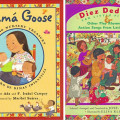
Last month, something happened that ignited a movement among a small group of Latinas. Motoko Rich, a writer for the New York Times, wrote an article sharing what so many of us Latina moms already knew: Our Latino children don’t have sufficient access to books that reflect their own faces and experiences.
I don’t know if Ms. Rich realized the stir her article would create. Quite honestly, I’m surprised it did, since I feel like I’ve been trying to rally the forces for years now on the Latin Baby Book Club. But a reaction is exactly what Ms. Rich caused as several Latina bloggers (myself included) decided to respond to the issue with posts that shared our opinions on the matter, as well as a short list of Latino literature that we recommend.
The truth is that Latino children’s literature is out there, though not in great numbers. In fact, it only accounts for a little over three percent (3%!!) of all the children’s books published each year in this country. That’s up from one percent a little more than five years ago. These numbers are appalling given the exponential growth of the Latino population. The 2010 Census recorded 50.5 million Hispanics in the United States, and 34% of them were under 17.
Read Related: The Missing Link: Latinos in Books & Publishing
A few years ago, many publishing houses turned their attention to producing work specifically for the “untapped” Latino market. But unfortunately, their traditional marketing techniques and the plunging economy worked against them and caused many to stop publishing this genre. Today, only a small handful of independent publishers, such as Arte Público, Groundwood Books, Lorito Books, and Cinco Puntos Press continue to publish books for Latino children by Latino artists.
The excuse that some of the larger publishers have claimed is that “Latinos don’t read.”
Excuse me? Coming from a Latino family of avid readers, I find that unbelievable.
The real reason Latinos weren’t buying books is actually twofold. First, when the economy tanked, Latinos were the hardest hit population. According to Pew Research, 6.1 million Latino children were living in poverty in 2010. For families struggling to put food on the table, books become a luxury that many simply cannot afford. Which is why our public libraries and schools play such an important role in providing our kids access to these books.
The second reason is that many Latino communities don’t have a major bookstore. Some Latino parents can’t just run down to the local Barnes & Noble for the latest book by Jorge Argueta or Lulu Delacre. And if they do happen to be located near such a bookstore, chances are it doesn’t carry many titles by Latino authors. One or two bookshelves with bilingual and bicultural books—most of which feature Dora the Explorer and Diego—leaves Latino parents with slim pickings for their children.
I have found the response I get from Latino parents whenever I share news about a Latino-focused children’s book is always favorable. They are, in fact, eager to find more bilingual and bicultural books for their children. Like me, they want their kids to see their own faces reflected in strong, positive leading characters, so that they grow up thinking about the possibilities and reach for them with confidence.
I am so excited that Mamiverse has created the Mamiverse Books section. It is such a valuable resource for parents. The best part about it, I think, is the layout that allows you to find books according to age: Picture books for children under 8, Middle Grade books for kids 8 to 12, and Young Adult novels. You can even browse their bilingual book section. If you haven’t already taken the Mamiverse Reads Pledge, please consider doing so!
And if you, too, would like to show your support of Latino authors and Latino children’s literature, we invite you to join us by liking the Latinas for Latino Literature Facebook page. There we share articles and interviews about Latino authors, as well as updates about our mission to see more of our stories in print.











